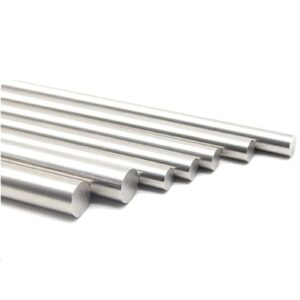Stainless steel alloys are renowned for their diverse properties and applications in various industries. Among these alloys, 316 stainless steel round bars stand out as a popular choice due to their unique characteristics. In this comprehensive guide, we will compare 316 stainless steel round bars to other alloys, exploring their differences, similarities, and applications.
Understanding 316 Stainless Steel
Before delving into comparisons, let’s first understand the key properties and attributes of 316 stainless steel.
Composition and Alloying Elements
316 stainless steel is classified as an austenitic stainless steel alloy, and its composition includes the following essential elements:
- Chromium (Cr): Provides resistance to corrosion by forming a protective oxide layer.
- Nickel (Ni): Enhances corrosion resistance, especially in acidic environments.
- Molybdenum (Mo): Improves resistance to pitting corrosion.
- Iron (Fe): The base metal that contributes to its strength and durability.
- Other Trace Elements: Including carbon, silicon, and manganese, which influence specific properties.
Corrosion Resistance
One of the standout features of 316 stainless steel is its exceptional corrosion resistance, making it suitable for applications in harsh environments, such as marine and chemical industries.
High Temperature Performance
316 stainless steel retains its mechanical properties at elevated temperatures, making it ideal for high-temperature applications.
Strength and Durability
These round bars are known for their impressive tensile strength and durability, making them suitable for structural and load-bearing purposes.
Comparing 316 Stainless Steel to Other Alloys
Now, let’s compare 316 stainless steel to some other commonly used alloys to understand how it stacks up in various scenarios.
316 Stainless Steel vs. 304 Stainless Steel
Corrosion Resistance
- 316 Stainless Steel: Offers superior corrosion resistance, particularly in chloride-rich environments.
- 304 Stainless Steel: Less resistant to corrosion in chloride-rich settings compared to 316.
High-Temperature Performance
- 316 Stainless Steel: Maintains its properties at higher temperatures than 304.
- 304 Stainless Steel: Shows reduced high-temperature performance compared to 316.
Strength and Durability
- 316 Stainless Steel: Generally stronger and more durable than 304 stainless steel.
316 Stainless Steel vs. 316L Stainless Steel
Carbon Content
- 316 Stainless Steel: Contains a higher carbon content.
- 316L Stainless Steel: Features lower carbon content (L stands for “low carbon”).
Sensitization Resistance
- 316 Stainless Steel: More prone to sensitization (a form of corrosion) in high-temperature applications.
- 316L Stainless Steel: Offers improved resistance to sensitization.
316 Stainless Steel vs. 17-4 PH Stainless Steel
Corrosion Resistance
- 316 Stainless Steel: Better suited for highly corrosive environments.
- 17-4 PH Stainless Steel: Known for its high strength but may not provide the same level of corrosion resistance as 316.
High-Temperature Performance
- 316 Stainless Steel: Generally more suitable for elevated temperature applications.
- 17-4 PH Stainless Steel: Offers exceptional strength at high temperatures.
Applications and Industries
Let’s explore some industries and applications where 316 stainless steel round bars excel.
Marine Industry
In maritime applications, 316 stainless steel is favored for its corrosion resistance, making it ideal for ship fittings, marine hardware, and boat propellers.
Chemical Processing
The chemical industry relies on 316 stainless steel due to its resistance to corrosive chemicals, making it suitable for reactors, pipelines, and storage tanks.
Food and Pharmaceutical Industries
For hygiene and corrosion resistance, 316 stainless steel is a top choice in food processing equipment and pharmaceutical machinery.
Construction and Architecture
In construction, these round bars find use in structural components, handrails, and architectural features due to their durability and aesthetic appeal.
FAQ
Q1: Is 316 stainless steel magnetic?
No, 316 stainless steel is typically non-magnetic in its annealed state. However, some slight magnetic properties may develop after cold working or fabrication processes.
Q2: Can 316 stainless steel be welded?
Yes, 316 stainless steel can be welded using standard welding techniques. However, it’s essential to use low-carbon filler materials to prevent sensitization and maintain corrosion resistance.
Q3: What are the limitations of 316 stainless steel?
While 316 stainless steel offers excellent corrosion resistance, it may not be suitable for extremely high-temperature applications (above 900°C or 1652°F), where specialized alloys may be required.
Q4: How does the cost of 316 stainless steel compare to other alloys?
316 stainless steel is generally more expensive than some other alloys like 304 stainless steel but is cost-effective when considering its corrosion resistance and performance in specific applications.
In conclusion, 316 stainless steel round bars stand out for their unique combination of corrosion resistance, high-temperature performance, strength, and durability. When compared to other alloys, 316 stainless steel proves to be an excellent choice for various industries, ensuring longevity and reliability in challenging environments.


